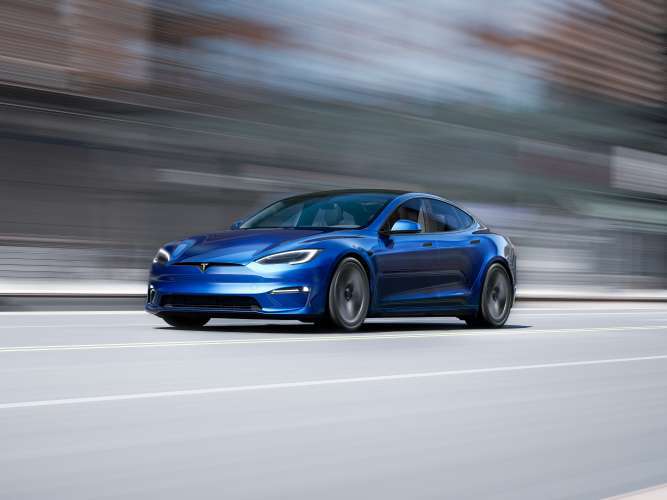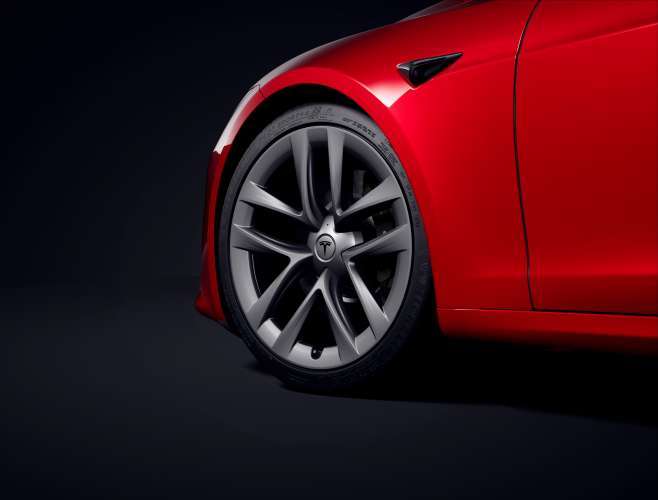After having been absent for a few months preparing its renewal, the access version of the Tesla Model S is once again available in the markets: it is the cheapest version of the Tesla supercar (although it is in fact not cheap at all) and the one with the longest range. Although the Plaid version takes the spotlight thanks to its spectacular 1,020 horsepower, the 'standard' version can also cause a huge impression with its range: the Austin brand announces more than 700 kilometers per charge, although to achieve this close attention to the tires must be paid.
If anyone looks for electric cars with the longest range in the world, a Tesla model will certainly appear. Not in first position, it must be said, but there is the Tesla Model S with a range of 634 kilometers in the WLTP cycle, the approved standard used in Europe. And there's a way to get even more range: by choosing the right tires. In the case of the Model S, the Tempest 19-inch aerodynamic wheels (standard) basically increase range to 723 kilometers (450 miles) per recharge.

According to Tesla's Europe website, the approved range of 634 kilometers (WLTP) is associated with the 21-inch “Arachnid” wheels, sportier and more visually attractive (depending on your taste as regarding colors, though). These wheels are an extra option, at $4,900, and it is in fact curious that Tesla did not choose the most favorable option possible when actually configuring the offer.
However, in the United States the opposite occurs: the range data is associated with 19-inch aerodynamic wheels and, for large wheels, an estimate is announced. According to Tesla's US website, the Model S gets 651 kilometers of range in the EPA cycle (405 miles) using the 19-inch wheels; while with the large ones the estimated range is 603 kilometers (375 miles).

At this point, and knowing that the range between recharges of the Model S may be greater (at least theoretically), it should be noted that the 723 Km range is an estimate by Tesla itself, not the data approved in the WLTP cycle. These are guideline values that most likely cannot be achieved under normal, real conditions. But in any case, it is by all means an impressive range and at the level (and even above) of a gasoline sedan in the “F” segment.
Having larger (and heavier) tires increases consumption in any type of car, electric or not. In this case there is also another fundamental difference: while the large rims have a beautiful, bare five-double-spoke design, the small ones are partially faired, which significantly reduces aerodynamic resistance and therefore, consumption. The fairings have become popular with electric cars, in which any improvement that increases range is appreciated; depending on the case, this type of tire can achieve up to 4.5% more range.
If we look at the competition we will be able to see two things, right away: that the Tesla Model S has only two direct rivals; and that, in terms of range, the competition is directly set between two brands: the BMW i7 reaches 624 kilometers in a best-case scenario, currently on sale in Europe (BMW i7 xDrive 60). It has 544 CV of power, a battery with 101.7 kWh of net capacity and the costs is 143,550 euros. As in the case of the Model S, it comes standard with 19-inch wheels with an aerodynamic design.

The Model S still lags behind the Mercedes EQS 450+, the electric car with the longest range on the market today. This version of the EQS announces 741 kilometers, and in this case it is a figure approved in the WLTP cycle. With a 333 CV power and rear-wheel drive, it is priced at 124,375 euros, mounting 20-inch wheels.
Source: hibridosyelectricos
All images courtesy of Tesla Inc.
Nico Caballero is the VP of Finance of Cogency Power, specializing in solar energy. He also holds a Diploma in Electric Cars from Delft University of Technology in the Netherlands, and enjoys doing research about Tesla and EV batteries. He can be reached at @NicoTorqueNews on Twitter. Nico covers Tesla and electric vehicle latest happenings at Torque News.











